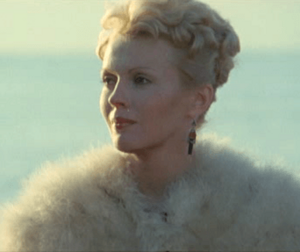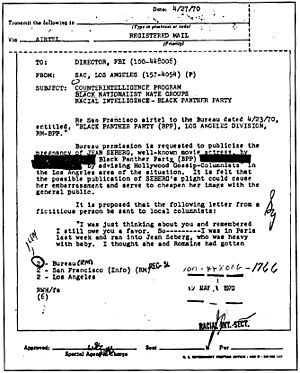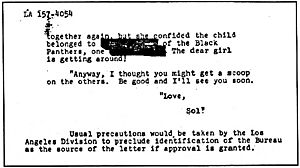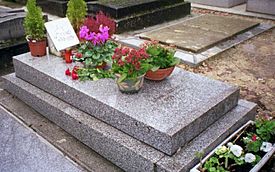Jean Seberg facts for kids
Quick facts for kids
Jean Seberg
|
|
|---|---|
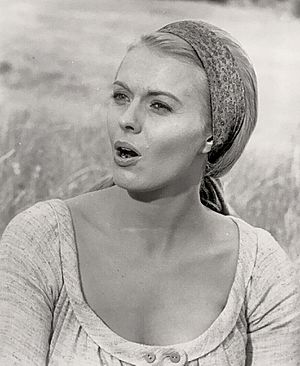
Seberg in 1969
|
|
| Born |
Jean Dorothy Seberg
November 13, 1938 Marshalltown, Iowa, U.S.
|
| Died | August 30, 1979 (aged 40) Paris, France
|
| Resting place | Montparnasse Cemetery |
| Alma mater | University of Iowa |
| Occupation | Actress |
| Years active | 1957–1979 |
| Spouse(s) |
François Moreuil
(m. 1958; div. 1960)Dennis Charles Berry
(m. 1972) |
| Children | 2 (1 deceased) |
Jean Dorothy Seberg (/ˈsiːbɜːrɡ/; French: [ʒin sebɛʁɡ]; November 13, 1938 – August 30, 1979) was an American actress who lived half of her life in France. Her performance in Jean-Luc Godard's 1960 film Breathless immortalized her as an icon of French New Wave cinema.
Seberg appeared in 34 films in Hollywood and in Europe, including Saint Joan, Bonjour Tristesse, Lilith, The Mouse That Roared, Breathless, Moment to Moment, A Fine Madness, Paint Your Wagon, Airport, Macho Callahan, and Gang War in Naples. Seberg was among the best-known targets of the FBI's COINTELPRO project. Her targeting was in retaliation for her support of the Black Panther Party, a smear directly ordered by J. Edgar Hoover.
Contents
Early life
Seberg was born in Marshalltown, Iowa, the daughter of Dorothy Arline (née Benson), a substitute teacher, and Edward Waldemar Seberg, a pharmacist. Her family was Lutheran and of Swedish, English, and German ancestry.
Her paternal grandfather, Edward Carlson, arrived in the U.S. in 1882 and observed, "there are too many Carlsons in the New World." He changed the family surname to Seberg in memory of the water and mountains of Sweden. Seberg had a sister, Mary-Ann, and two brothers, Kurt and David, the younger of whom was killed in a car accident at the age of 18 in 1968.
In Marshalltown, Seberg babysat Mary Supinger, some eight years her junior, who became stage and film actress Mary Beth Hurt. After high school, Seberg enrolled at the University of Iowa to study dramatic arts, but took up filmmaking instead.
Film career
Otto Preminger
Seberg made her film debut in the title role of Joan of Arc in Saint Joan (1957), based on the George Bernard Shaw play, having been chosen from among 18,000 hopefuls by director Otto Preminger in a $150,000 talent search. Her name was entered by a neighbor.
When she was cast on October 21, 1956, Seberg's only acting experience had been a single season of summer stock performances. The film generated a great deal of publicity, but Seberg commented that she was "embarrassed by all the attention." Despite great hype, called in the press a "Pygmalion experiment", both the film and Seberg received poor reviews. On the failure, she later told the press:
I am the greatest example of a very real fact, that all the publicity in the world will not make you a movie star if you are not also an actress.
She also recounted:
I have two memories of Saint Joan. The first was being burned at the stake in the picture. The second was being burned at the stake by the critics. The latter hurt more. I was scared like a rabbit and it showed on the screen. It was not a good experience at all. I started where most actresses end up.
Preminger promised her a second chance, and he cast Seberg in his next film, Bonjour Tristesse (1958), which was filmed in France. Preminger told the press: "It's quite true that, if I had chosen Audrey Hepburn instead of Jean Seberg, it would have been less of a risk, but I prefer to take the risk. [..] I have faith in her. Sure, she still has things to learn about acting, but so did Kim Novak when she started." Seberg again received negative reviews and the film nearly ended her career.
Seberg renegotiated her contract with Preminger and signed a long-term contract with Columbia Pictures. Preminger had an option to use her on another film, but they never again worked together. Her first Columbia film was the successful comedy The Mouse That Roared (1959), starring Peter Sellers.
Mylène Demongeot recalled in a 2015 filmed interview in Paris: "Otto had high hopes in Jean and Saint Joan's failure took a toll on him also because there was a 5-films-contract from what I recall. She was extremely sad too about it and when we all arrived on the set of Bonjour Tristesse she carried on her shoulders the weight of guilt, she was scared. And with that type of man, of character [Preminger] she shouldn't have shown fear, that's why I got along with him. I was a supporting role, I didn't have the weight of the expected success of the film on my shoulders. I had no apprehension regarding him. When he screamed, I would turn and tell him [sarcastically] "you know, you shouldn't screech like that, you gonna get yourself a stroke". Such words would defuse him. On the contrary, Jean was scared of him so he would take advantage and eventually became very mean to her."
Breathless and French career
During the filming of Bonjour Tristesse, Seberg met François Moreuil, the man who was to become her first husband, and she then based herself in France, finally achieving success as the free-love heroine of French New Wave films.
She appeared as the female lead in Jean-Luc Godard's Breathless (French title: À bout de souffle, 1960) as Patricia, co-starring with Jean-Paul Belmondo. The film became an international success and critics praised Seberg's performance; film critic and director François Truffaut even hailed her as "the best actress in Europe." Despite her achievements, Seberg did not identify with her characters or the film plots, saying that she was "making films in France about people [I'm] not really interested in." Back in the U.S., she made another film for Columbia, the crime drama Let No Man Write My Epitaph (1960).
In France, after appearing in Time Out for Love (Les grandes personnes, 1961), Seberg took the lead role in Moreuil's directorial debut, Love Play (La Recréation, also 1961). By that time, Seberg had become estranged from Moreuil, and she recollected that production was "pure hell" and that he "would scream at [her]." She followed with Five Day Lover (L'amant de cinq jours, 1962), Congo vivo (1962) and In the French Style (1963), a French-American film featuring Stanley Baker released through Columbia. She also appeared in the anthology film The World's Most Beautiful Swindlers (Les plus belles escroqueries du monde, 1963) and Backfire (Échappement libre, 1964), which reunited her with Jean-Paul Belmondo.
Seberg starred with Warren Beatty in the American film Lilith (1964) for Columbia, which prompted the critics to acknowledge Seberg as a serious actress. She returned to France to make romantic crime drama Diamonds Are Brittle (Un milliard dans un billard, 1965).
Return to Hollywood
In the late 1960s, Seberg was increasingly based in Hollywood. Moment to Moment (1965) was mostly filmed in Los Angeles; only a small part of the film was shot on the French Cote d'Azur. In New York City, she acted in the comedy A Fine Madness (1966) with Sean Connery and under the direction of Irvin Kershner.
In 1966 and 1967, Seberg played the leading roles in two French films directed by Claude Chabrol and co-starring Maurice Ronet. In February and March 1966, she starred in Line of Demarcation, filmed around Dole, Jura, and in May and June 1967, she played the lead role in the French-Italian Eurospy film The Road to Corinth, shot in Greece.
After making the crime drama Pendulum with George Peppard (1969), Seberg appeared in her only musical film, Paint Your Wagon (also 1969), based on Lerner and Loewe's stage musical and co-starring Lee Marvin and Clint Eastwood. Her singing voice was dubbed by Anita Gordon. The film was a critical and box office disaster. Seberg also starred in the ensemble disaster film Airport (1970), which drew mixed reviews but was a huge success at the box office.
Later career
Seberg acted in the western Macho Callahan (1970) and the violent crime drama Kill! Kill! Kill! Kill! (1971), but both films were failures. In 1972, she appeared in Gang War in Naples, which was successful in Europe but not in the United States.
Seberg was François Truffaut's first choice for the central role of Julie in Day for Night (La Nuit américaine, 1973), but after several fruitless attempts to contact her, he gave up and cast British actress Jacqueline Bisset instead.
Seberg's last American film appearance was in the TV movie Mousey (1974). She remained active during the 1970s in European films, appearing in Bianchi cavalli d'Agosto (White Horses of Summer) (1975), Le Grand Délire (The Big Delirium, 1975, with husband Dennis Berry) and Die Wildente (1976, based on Ibsen's The Wild Duck).
At the time of Seberg's death, she was working on the French film Operation Leopard (La Légion saute sur Kolwezi, 1980), which was based upon the book by Pierre Sergent. She had filmed scenes in French Guiana and returned to Paris for additional work in September. After her death, the scenes were reshot with actress Mimsy Farmer.
FBI COINTELPRO operation
During the late 1960s, Seberg provided financial support to groups supporting civil rights, such as the NAACP as well as Native American school groups such as the Meskwaki Bucks at the Tama settlement near her hometown of Marshalltown, for whom she purchased $500 worth of basketball uniforms.
As part of its "dirty tricks" aimed at black liberation and anti-war groups, which began in 1968, the FBI became aware of several gifts Seberg had made to the Black Panther Party, totaling an estimated $10,500 in contributions; these were noted among a list of other celebrities in FBI internal documents later declassified and released to the public under FOIA requests.
The FBI operation against Seberg, directly overseen by J. Edgar Hoover, used COINTELPRO program techniques to harass, intimidate, defame, and discredit her. The FBI's stated goal was an unspecified "neutralization" of Seberg with a subsidiary objective to "cause her embarrassment and serve to cheapen her image with the public", while taking the "usual precautions to avoid identification of the Bureau." The FBI's strategy and modalities can be found in its interoffice memos.
In 1970, the FBI created a false story from a San Francisco-based informant that the child whom Seberg was carrying was not fathered by her husband, Romain Gary, but by Raymond Hewitt, a member of the Black Panther Party. The story was reported by gossip columnist Joyce Haber of the Los Angeles Times, with Seberg thinly disguised. It was also printed by Newsweek magazine, in which Seberg was directly named. Seberg went into premature labor and, on August 23, 1970, gave birth to a 4 lb (1.8 kg) baby girl. The child died two days later. Seberg held a funeral in her hometown with an open casket that allowed reporters to see the infant's white skin in order to disprove the rumors.
Seberg and Gary later sued Newsweek for libel and defamation, asking for $200,000 in damages. She contended that she had become so upset after reading the story that she went into premature labor, which resulted in the death of her daughter. A Paris court ordered Newsweek to pay the couple $10,800 in damages, and it ordered Newsweek to print the judgment in its publication and eight other newspapers.
The Seberg investigation went far beyond the publishing of defamatory articles. According to friends interviewed after her death, she experienced years of aggressive in-person surveillance, amounting to constant stalking, as well as break-ins and other means of intimidation. These newspaper reports make clear that Seberg was well aware of the surveillance. FBI files show that she was wiretapped, and in 1980, the Los Angeles Times published logs of her Swiss wiretapped phone calls. U.S. surveillance was deployed while she was residing in France and while traveling in Switzerland and Italy. The FBI files reveal that the agency contacted the FBI legal attachés in American embassies in Paris and Rome and provided files on Seberg to the CIA, Secret Service and military intelligence to assist in monitoring Seberg while she was abroad.
Two weeks after Seberg's death in 1979, the FBI admitted what it had done in 1970. FBI records show that Hoover kept President Richard Nixon informed of FBI activities related to the Seberg case through Nixon's domestic affairs chief John Ehrlichman. Attorney General John Mitchell and Deputy Attorney General Richard Kleindienst were also kept informed of FBI activities related to Seberg. At the time of the FBI's admission of its activities, Haber was no longer writing a column, having been fired in 1975 for often using unattributed information in her column. Following the FBI's admission, Haber said she could not disclose the source of the information from her column and said, "If I were used by the FBI, I didn't know it. ... I am certainly shocked to learn that the FBI engaged in planting stories with news people."
Possible Hollywood blacklisting
At the peak of her career, Seberg suddenly stopped acting in Hollywood films. Reportedly, she was not pleased with the roles that she had been offered. She was not offered any great Hollywood roles, regardless of their size. Experts on the FBI's actions in the COINTELPRO project suggest that Seberg was "effectively blacklisted" from Hollywood films.
Personal life
On September 5, 1958, at the age of 19, Seberg married François Moreuil, a French lawyer (aged 23) in her native Marshalltown, having met him in France 15 months earlier. They divorced in 1960. Moreuil had ambitions to work in film and directed his estranged wife in Love Play. He said that the marriage was "violent" and that Seberg "got married for all the wrong reasons."
On living in France for a period of time, Seberg said in an interview:
I'm enjoying it to the fullest extent. I've been tremendously lucky to have gone through this experience at an age where I can still learn. That doesn't mean that I will stay here. I'm in Paris because my work has been here. I'm not an expatriate. I will go where the work is. The French life has its drawbacks. One of them is the formality. The system seems to be based on saving the maximum of yourself for those nearest you. Perhaps that is better than the other extreme in Hollywood, where people give so much of themselves in public life that they have nothing left over for their families. Still, it is hard for an American to get used to. Often I will get excited over a luncheon table only to have the hostess say discreetly that coffee will be served in the other room. ... I miss that casualness and friendliness of Americans, the kind that makes people smile. I also miss blue jeans, milk shakes, thick steaks and supermarkets.
Despite extended stays in the United States, Seberg remained in Paris for the rest of her life. In 1961 she met French aviator, resistance member, novelist and diplomat Romain Gary, who was 24 years her senior and married to author Lesley Blanch. Seberg gave birth to their son, Alexandre Diego Gary, in Barcelona on July 17, 1962. The child's birth and first year of life were hidden, even from close friends and relatives. Gary's divorce from Blanch took place on September 5, 1962, and he married Seberg secretly on October 6, 1962, in Corsica.
During her marriage to Gary, Seberg lived in Paris, Greece, Southern France and Majorca. She filed for divorce in September 1968, and the divorce was finalized on July 1, 1970. As of 2009, their son resides in Spain, where he runs a bookstore and oversees his father's literary and real-estate holdings.
While filming Macho Callahan in Durango, Mexico, in the winter of 1969–70, Seberg became romantically involved with a student revolutionary named Carlos Ornelas Navarra. She gave birth to their daughter, Nina Hart Gary, on August 23, 1970. The baby died two days later on August 25, 1970. Ex-husband Gary assumed responsibility for the pregnancy, but Seberg acknowledged that Ornelas was the father. Nina is buried at Riverside Cemetery in Marshalltown.
On March 12, 1972, Seberg married director Dennis Berry. The couple separated in May 1976, but never divorced. Seberg subsequently dated aspiring French filmmaker Jean-Claude Messager, who later spoke to CBS's Mike Wallace for a 1981 profile of the actress.
In 1979, while still legally married to her estranged husband Berry, Seberg went through "a form of marriage" to Algerian Ahmed Hasni. Hasni persuaded her to sell her second apartment on the Rue du Bac, and he kept the proceeds (reportedly 11 million francs in cash), announcing that he would use the money to open a Barcelona restaurant. The couple departed for Spain, but she was soon back in Paris alone, and went into hiding from Hasni.
Death
Seberg died at the age of 40 in Paris. She is interred at the Cimetière du Montparnasse in Paris.
In popular culture
The Talent Scout by Romain Gary (1961) features a recognizable portrait of Seberg.
In 1983, a musical based on Seberg's life called Jean Seberg, by librettist Julian Barry, composer Marvin Hamlisch and lyricist Christopher Adler, was presented at the National Theatre in London.
In 1986, pop singer Madonna recreated Seberg's iconic Breathless look in her music video for "Papa Don't Preach," sporting a pixie blonde haircut, French striped jersey shirt and black capri pants in the style of Seberg's character in Breathless.
In 1991, actress Jodie Foster, a fan of Seberg's performance in Breathless, purchased the film rights to Played Out: The Jean Seberg Story, David Richards' biography of Seberg. Foster was set to produce and star in the film, but the project was canceled two years later.
In 1995, Mark Rappaport created a documentary about Seberg, From the Journals of Jean Seberg. Mary Beth Hurt played Seberg in a voiceover. Hurt was born in Marshalltown, Iowa in 1948, attended the same high school as Seberg and was babysat by Seberg.
The plot of the 1998 film Black Tears, starring Ariadna Gil, is reportedly inspired by Seberg's reported affair with Ricardo Franco.
The 2000 short film Je t'aime John Wayne is a tribute parody of Breathless, with Seberg played by Camilla Rutherford.
In 2004, French author Alain Absire published Jean S., a fictionalized biography. Seberg's son Alexandre Diego Gary brought a lawsuit, unsuccessfully attempting to stop publication.
Also from 2004, Seberg is recalled in the Divine Comedy song "Absent Friends": Little Jean Seberg seemed / So full of life / But in those eyes such troubled dreams / Poor little Jean".
Since 2011, Seberg's hometown of Marshalltown, Iowa, has held an annual Jean Seberg International Film Festival.
In 2019, Amazon released an original film based on Seberg's life called Seberg that focuses on her battle against the FBI, with the title role played by Kristen Stewart.
The character of Anny Vikland in William Boyd’s 2020 novel ‘Trio’ strongly resembles Seberg’s in details of her life and death.
In 2022, Kacey Rohl portrayed Seberg in White Dog (Chien blanc), a film adaptation by Anaïs Barbeau-Lavalette of Gary's 1970 book.
Filmography
| Year | Title | Role | Language | Notes |
|---|---|---|---|---|
| 1957 | Saint Joan | St. Joan of Arc | English | |
| 1958 | Bonjour Tristesse | Cecile | English | |
| 1959 | The Mouse That Roared | Helen Kokintz | English | |
| 1960 | Breathless | Patricia Franchini | French | |
| 1960 | Let No Man Write My Epitaph | Barbara Holloway | English | |
| 1961 | Time Out for Love | Ann | French | |
| 1961 | Love Play | Kate Hoover | French | |
| 1961 | Five Day Lover | Claire | French | |
| 1962 | Congo vivo | Annette | Italian | |
| 1963 | In the French Style | Christina James | English | |
| 1964 | The World's Most Beautiful Swindlers | Patricia Leacock | French | (segment "Le Grand Escroq") (scenes deleted) |
| 1964 | Backfire | Olga Celan | French | |
| 1964 | Lilith | Lilith Arthur | English | |
| 1965 | Diamonds Are Brittle | Bettina Ralton | French | |
| 1966 | Moment to Moment | Kay Stanton | English | |
| 1966 | A Fine Madness | Lydia West | English | |
| 1966 | Line of Demarcation | Mary, comtesse de Damville | French | |
| 1967 | The Looters | Colleen O'Hara | French | Alternate title: Revolt in the Caribbean |
| 1967 | The Road to Corinth | Shanny | French | Alternate title: Who's Got the Black Box? |
| 1968 | Birds in Peru | Adriana | French | |
| 1968 | The Girls | English | Documentary | |
| 1969 | Pendulum | Adele Matthews | English | |
| 1969 | Paint Your Wagon | Elizabeth | English | |
| 1970 | Airport | Tanya Livingston | English | |
| 1970 | Dead of Summer | Joyce Grasse | Italian | |
| 1970 | Macho Callahan | Alexandra Mountford | English | |
| 1972 | Kill! Kill! Kill! Kill! | Emily Hamilton | English | |
| 1972 | This Kind of Love | Giovanna | Italian | |
| 1972 | Gang War in Naples | Luisa | Italian | |
| 1972 | Plot | Edith Lemoine | French | Alternate title: The French Conspiracy |
| 1973 | The Corruption of Chris Miller | Ruth Miller | Spanish | |
| 1974 | Les hautes solitudes | — | Silent film without named characters | |
| 1974 | Mousey | Laura Anderson / Richardson | English | Television film |
| 1974 | Ballad for the Kid (Short film) | La star | French | Director, writer, producer |
| 1975 | White Horses of Summer | Lea Kingsburg | Italian | |
| 1975 | The Big Delirium | Emily | French | |
| 1976 | The Wild Duck | Gina Ekdal | German | (Final film role) |
Awards and nominations
British Academy Film Awards
| Year | Category | Film | Result |
|---|---|---|---|
| 1962 | Best Film Actress in a Leading Role | Breathless | Nominated |
Golden Globe Awards
| Year | Category | Film | Result |
|---|---|---|---|
| 1965 | Best Actress – Motion Picture Drama | Lilith | Nominated |
See also
 In Spanish: Jean Seberg para niños
In Spanish: Jean Seberg para niños
- List of solved missing person cases


